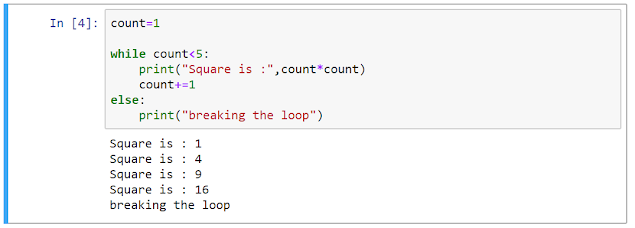Hello Folks...!!!
Today we shall see how to use while loops for iterating through the data structures....
Example 1:
Consider the sentence: s="learning python is very easy." . Now the task is to capitalize each word of the sentence. See the code
below:
- We first split the sentence into list of words.
- Then we store the length of the list in the variable 'n'. We initialize the loop control variable 'i' to '0'
- We define a loop stating that, until 'i' remains less than the length of the list.
- Inside the loop, we use capitalize() to capitalize each word and store it back in the same index in the list.
- We join the list and store it back in the string variable 's'.
Example 2:
Minu is trying to decode a secret message.The message is "yawa rotcod eth speek yad a elppa na". She found that every word is reversed and the whole sentence is also
reversed. Now let us help her decode it programatically.
Example 3:
Now I will code a simple placement problem - 'Array rotations'
If you come across such a problem, it is nothing but rotate the list
for specified number of times.
For example:
Given list : [1,2,3,4,5]
No.of.rotations: 2
Resultant list: [3,4,5,1,2]
Let us look at the solution now :
First we store the element at index '0' in a temporary variable, then
we remove it out and the add it at the end of the list.
break and continue in loops:
One can either break the loop or continue without executing the
statements below using the keywords 'break' and 'continue'.
Example 4: Consider the pattern below :
1
333
55555
7777777
999999999
A pyramid of odd numbers below 10. Let us look at the coding :
What we do here !?
- The first loop checks whether the number is less than 10.
- The if condition checks whether it is an odd number or an even one.
- If it is an even number, then without executing the next if-condition and statements below, it continues the first while loop. If you do not use a continue here, it will check the next if-condition also.
- If it is an odd number then the further proceeding for printing it out is carried out.
- We have a variable 'space' initialized to 10. It is used to print the number in appropriate place leaving space before it.
- Thus the second while loop is concerned with the alignment.
- The third while loop prints the number.
- When 'i' increases, space has to decrease. So we decrement space in the outer most loop.
This is how we print a pyramid pattern.
Example 5:
Let it be a game. You must get input from the user and display it.
Once the user hits a number greater than 10, It must exit the loop and
stop getting input from user.
With this simple last example, we will finish the while loops
concept.
Python provides you a provision to use 'else' with 'while' loops. You
can give the instructions to be executed if the while loop fails in
the else part. For example:
Example 6:
Here when the count is less than 5, its square is printed. When it is
exceeded, the loop is not simply terminated, but a message is also
displayed.






Comments
Post a Comment